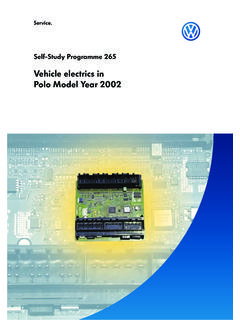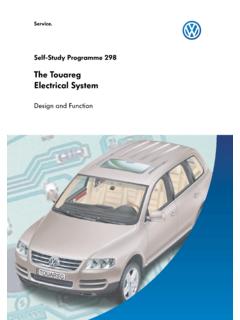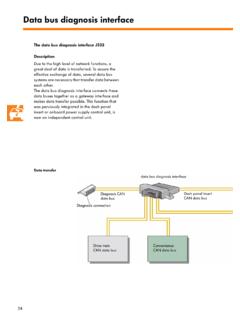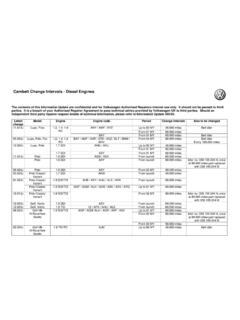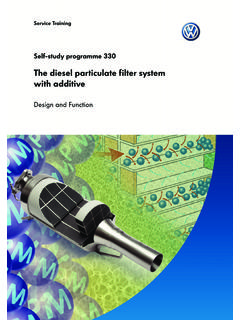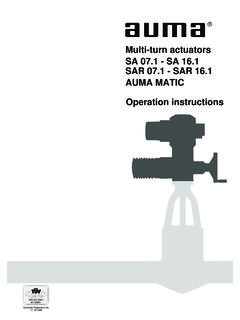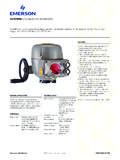Transcription of SSP346 - The electromechanical parking brake
1 Service TrainingSelf-study programme 346 The electromechanical parking brakeDesign and function2 This self-study programme shows the design and function of new developments!The contents will not be current testing, adjustment and repairinstructions, refer tor the relevant service literatureTo make absolutely sure that the vehicle could not roll away when parked up, the driver had to pull up sharply on the handbrake lever until now or step on an additional parking brake pedal in the footwell. In the future, all that will be required is a quick press of a switch in the instrument panel thanks to the electromechanical parking brake in the new Passat replacing the conventional, manual parking brake . S346_001 NEWC autionNoteThe electromechanical parking brake doesn't just help with parking . Due to its intelligent brake intervention system, safe braking is assured and the required hold is provided for hill starts. The electromechanical parking brake is also referred to in other publications as an electrical parking brake (EPB).
2 3 Introduction ..4 System overview .. 6 System components .. 7 Function .. 19 Special features..29 CAN network..32 Function diagram ..33 Test your knowledge.. 34 Contents4 IntroductionGeneral overview of electromechanical parking brake systemS346_095 electromechanical parking brake buttonAUTOHOLD buttonABS control unitElectromechanical parking brake control unitRear brake actuatorsClutch position sender5 The advantages of the electromechanical parking brakeThe electromechanical parking brake offers many advantages over the conventional handbrake, such as for example: Greater freedom in designing the interiorThe handbrake lever has been discontinued and replaced by a button. This allows greater freedom in the interior layout and in designing the centre console and footwell area. Greater functionality for the customerWith the use of an electronic control system and CAN network, the electromechanical parking brake offers additional helpful functions for the customer (such as AUTOHOLD or dynamic drive off assistant) and a higher level of comfort.
3 Advantages in the manufacturing processSince the handbrake lever and handbrake cables are no longer needed, production and assembly of the vehicle have been simplified. Capable of self-diagnosisThe electromechanical parking brake is a mechatronic system. The system functions are monitored on an ongoing electromechanical parking brake in comparisonConventional handbrakeElectromechanical parking brakeOperationPull up handbrake leverPress electromechanical parking brake buttonReleasingRelease handbrake leverPress electromechanical parking brake buttonHillstartComplicated balance between handbrake, accelerator and clutch pedalThe electromechanical parking brake releases itself when the vehicle is driven and goContinual application and release of handbrake or actuation of brake pedalWhen the AUTOHOLD function is switched on, the vehicle is held automatically each time it is brought to a overviewSensorsActuatorsClutch position sender G476 electromechanical parking brake button E538 AUTOHOLD button E540 electromechanical parking brake control unit J540 ABS control unit J104 Left parking brake motor V282 Right parking brake motor V283 electromechanical parking brakewarning light K213 brake system warning light K118 electromechanical parking brake faultwarning lamp K214 AUTOHOLD warning lamp K237S346_0627 System componentsThe rear brake actuatorsThe brake actuators are electromechanical positioning units and are integrated in the brake calipers of the rear wheels.
4 With the help of an electric motor, a multi-staged gear mechanism and a spindle drive, they convert the command to "actuate the parking brake " to a targeted force, which brings the brake pads in contact with the brake motor ( parking brake motor)Multi-stage gear mechanismBrake caliperS346_0418 System componentsGearboxTo actuate the brakes by electromechanical means, only a very small stroke of the brake pistons is necessary. Conversion of rotary electric motor motion to a linear movement with total ratio of 1:150 is carried out in three stages. That means 150 rotations of the electric motor results in one turn of the spindle drive. 1st stage - Gear mechanismThe gear reduction stage (1:3) is performed from the electric motor to the swash plate gear stage - Swash plate gear The second gear reduction stage (1:50) is made possible by the swash plate stage - Spindle driveThe spindle drive converts rotary motion to a linear movement in the third motorSwash plate gearGear mechanismBrake pistonSpindle driveSwash plate gearS346_032S346_034 brake piston9 Spindle driveThe spindle drive converts rotary motion to an up and down movement (stroke).
5 The spindle is driven directly by the swash plate gear. The direction of rotation of the spindle determines whether the thrust nut on the spindle is moved forwards or backwards. The thrust nut has longitudinal mountings in the brake piston. This means that it is restricted to axial movement. The inner shape of the brake piston and the shape of the thrust nut prevent the nut from twisting. The spindle mechanism is of the self-locking design. Once the electromechanical parking brake has been actuated, the system remains locked even without electrical nutSpindle threadBrake pistonBrake pistonThrust nutS346_044S346_038S346_036 Spindle10 System componentsGear mechanismToothed gear, small (electric motor output)Gear wheel, large(swash plate gear input)Toothed beltThe gear mechanism is responsible for the first gear reduction stage (1:3) from electric motor to swash plate gear. The gear mechanism comprises a small gear wheel (electric motor output) and a large gear wheel (swash plate gear input).
6 Both gear wheels are joined together by the toothed belt. The size of the gear wheels determines the plate gearGear wheel, large (swash plate gear input)Swash plateOutput gearShaftLugLugThe swash plate gear is responsible for the second gear reduction stage (1:50).It comprises a large gear wheel, the swash plate and the output gear. The swash plate is mounted in the housing with two lugs that prevent it from turning. This type of mounting only permits the roll motion. S346_046S346_04011 ShaftHubaOffset angleMeshing of teeth Swash plate/output gearMeshing of teeth Swash plate/output gearPosition 1 Position 2 This sequence of movements results in the output gear being turned by one width of a tooth each time the large gear wheel completes one full rotation. Since the output gear has 50 teeth, the large gear wheel must make 50 rotations before the output gear can make 1 rotation. The result is a gear ratio of 1 plateOutput gearS346_042S346_050S346_114To o t h f l a n kThe shaft is securely joined to the output gear.
7 The large gear wheel is mounted on this shaft. The swash plate is pushed onto the hub of the large gear wheel. This hub is designed so as to allow an offset angle between the hub and the shaft. This offset angle triggers the roll motion of the swash plate. During one rotation of the large gear wheel, two teeth of the swash plate and output gear respectively will always engage. This means that engagement always occurs at the position where the hub of the large gear wheel has the lowest material thickness (a). The swash plate / output gear pair therefore engage in position 2 of the swash plate after half a turn of the large gear wheel. The swash plate has 51 teeth, whereas the output gear has 50. This means that a tooth will never fit perfectly in a tooth gap. One tooth from the swash plate therefore will always contact the flank of a tooth from the output gear. Due to this thrusting motion, the output gear moves itself a small degree output gear thereby moves further in position 1 so that in the next position too up to position 2 the tooth from the swash plate comes into contact with the flank of a tooth from the output componentsFunction of rear wheel brake actuatorsElectromechanicalSpindleSwash plate gearThrust nutBrake pistonBrake linings/padsSealBrake discSealThrust nutBrake pistonElectric motorS346_078S346_076If the parking brake is to be applied, the electric motor is actuated by the electromechanical parking brake control unit.
8 The spindle is driven by the electric motor via the belt and swash plate gear mechanism. Through the rotary movement of the spindle, the thrust nut moves forwards on the spindle thread. The thrust nut comes into contact with the brake piston and presses it against the brake pads. The brake pads press against the brake disc. When this happens, the seal is pressed out of shape towards the brake pads. The pressure results in an increase in current draw from the electric motor. During the whole brake application procedure, the electromechanical parking brake control unit measures the current draw of the electric motor. If the current draw exceeds a certain figure, the control unit switches off the current supply to the electric the parking brake is released, the thrust nut is spun back on the spindle. The brake piston is relieved of pressure. The reshaping of the seal and possibly imbalance of the brake disc cause the brake piston to move back.
9 The brake pads release the brake the event of a dynamic emergency stop (pressing of electromechanical parking brake button while the vehicle is in motion), the pressure of the brake fluid is increased via the brake line. This pressure causes the brake piston to press against the brake pads. The brake pads press against the brake disc. When this happens, the seal is pressed out of shape towards the brake pads. On completion of the braking manoeuvre, the pressure of the brake fluid drops. The brake piston is relieved of pressure. The reshaping of the seal and possibly imbalance of the brake disc cause the brake piston to move back. The brake pads release the brake pistonSealBrake discSealBrake pistonBrake linings/padsHydraulic connection, brake lineBrake fluidHydraulic connection, brake lineS346_072S346_07414 System componentsThe clutch position sender G476 The clutch position sender is clipped onto the master cylinder. This sender detects when the clutch pedal is signal from the clutch position sender is used: for engine start, to switch off the cruise control system, to reduce the injection volume briefly and thereby prevent engine jolts during gear changes and for the "dynamic drive-off assist" function of the electromechanical parking pedal with clutch position senderS346_097 DesignThe master cylinder is attached to the bearing bracket via a bayonet the clutch pedal is actuated, the plunger moves the piston in the master positionsenderPiston withpermanent magnetPlungerPedal travelS346_098 Bearing bracketClutch mastercylinder15 When the clutch pedal is pressed, the push rod and plunger are pushed in direction of the clutch position sender.
10 At the front end of the piston is a permanent magnet. Integrated in the clutch position sender are three Hall senders on a soon as the permanent magnet passes over the Hall senders, the electronics send signals to the relevant control units. Plunger withpermanent magnetPlungerHall sender 1S346_100 Clutch position senderSignal voltage to engine control unitHall sender 2 Hall sender 3 FunctionHall sender 1 is a digital sender. It sends its voltage signal to the engine control unit. The signal results in the cruise control system being switched sender 2 is an analogue sender. It sends a pulse-width modulated signal (PWM signal) to the electromechanical parking brake control unit. The exact position of the clutch pedal is thereby detected and the control unit can calculate the optimum release point of the parking brake for purposes of dynamic sender 3 is a digital sender. It sends its voltage signal to the onboard power supply control unit.
